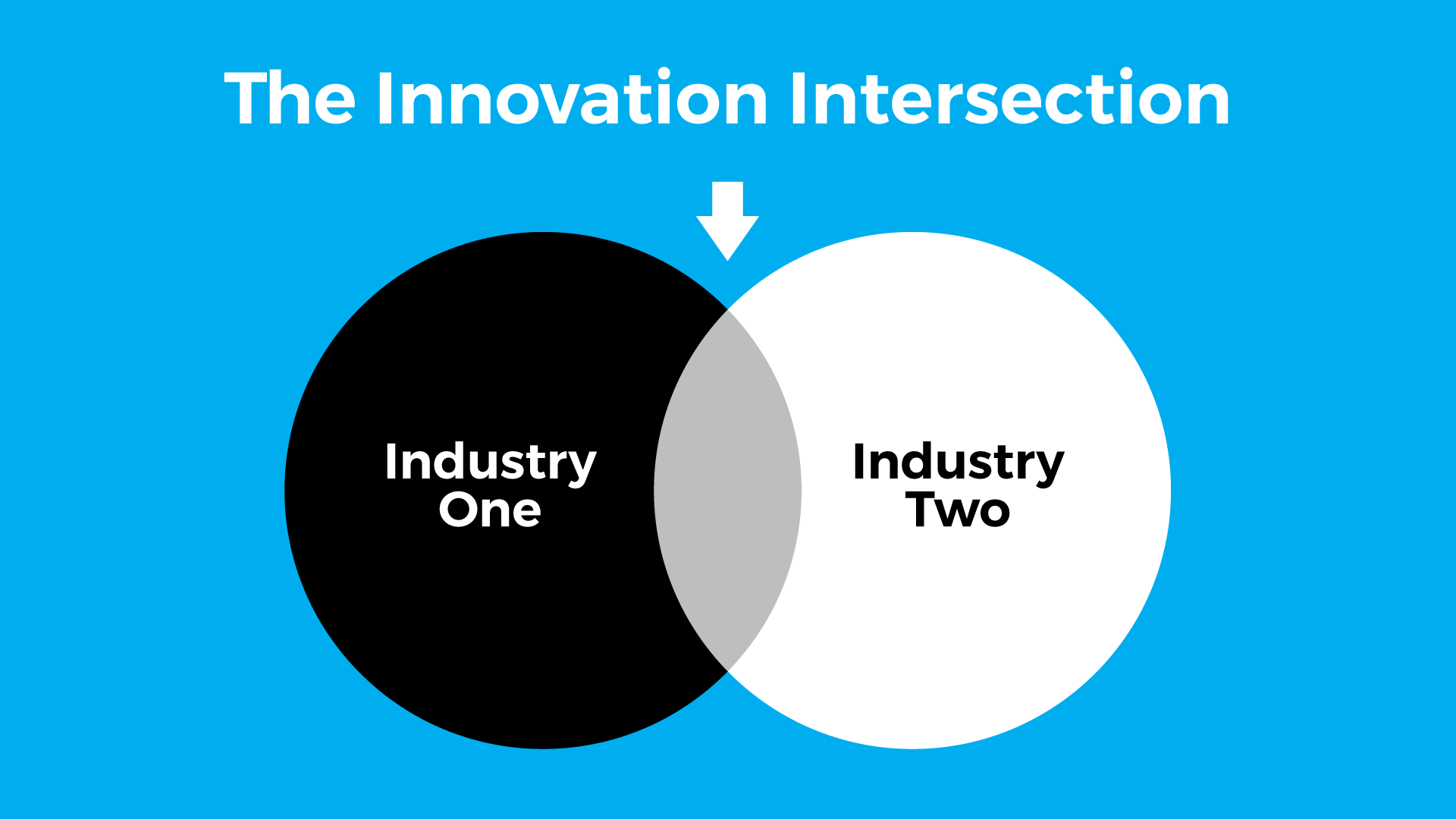Today’s brand visibility is being found when two seemingly disparate categories collide in unexpected ways, creating new ideas and genuine innovations. At Brand IQ, we call this ‘The Innovation Intersection’.

When Steve Jobs dropped into a calligraphy class at Reed College in Portland, Oregon in 1973, he was fascinated with the art and later credited this fascination with his passion for creating more aesthetically pleasing computer graphics that differentiated the Apple brand. Jobs fused calligraphy and computing technology to create something exceptional at the intersection of the two categories.
The Medici Effect
Swedish author Frans Johansson wrote a well-versed book about intersectional thinking in 2004 called “The Medici Effect”.
The Medici family lived in Florence during the Italian Renaissance. Being a family of considerable wealth, they became benefactors of artists, scholars and scientists who were drawn to schools they sponsored from all over the world. Great innovators of various backgrounds and cultures were given freedom to explore and innovate across a variety of disciplines creating a hotbed of creative energy and collaboration. Of their number we find artists such as Botticelli, da Vinci, and Michelangelo. Scientists, scholars and artists were encouraged to engage in meaningful conversations that resulted in an environment where ground-breaking new ideas emerged.
Johansson uses this as an example of how extraordinary new concepts and ideas can emerge when innovators from various backgrounds step into the intersection of differing fields, disciplines or cultures. It is at these intersections that established concepts clash with one another, and the resulting interaction can often produce remarkable new concepts and ideas.
Leonardo da Vinci worked at the intersection of science and art. One of his well-known quotes is:
“To develop a complete mind: Study the art of science; study the science of art. Learn how to see. Realize that everything connects to everything else.”
Why purple cows are no longer attracting attention.
In 2002 Seth Godin wrote his breakthrough book, Purple Cow. The idea behind the book was that to stand out we need to be remarkable, worth talking about, worth noticing, exceptional.
Almost 18 years later the world has changed, and brands are again having a differentiation problem. We are faced with great challenges that require thinking that is beyond the “purple cow”. Purple cows are not that uncommon anymore. In today’s fast-moving digital world, it’s easy to paint a cow purple. Metaphorically, purple cows are a dime a dozen. Most product categories have become crowded, homogenised, and lost in a sea of sameness. The market has become hyper competitive and saturated with way too many products. Everyone looks and feels the same. At the end of the day, black or brown, purple or pink, it’s still a cow!
The challenge today is first to differentiate yourself from your competitors (being purple isn’t going to cut it anymore). And second, make sure your ‘different’ is also ‘helpful’. Unless you are supremely useful, your differentiation will not be sustainable. In today’s marketplace people are not looking for novelties, but results. Start looking at the innovation intersection between your brand or product and something unexpected.
Products and brands exploring the innovation intersection
The fastest growing product in the bicycle market today is the e-bike. Bicycles have seen many innovations over the years. There was the single speed, the three speed, the chopper, the ten-speed racing bike, then the mountain bike. But a bike is a bike. The market became crowded. Although the first e-bike was invented in 1895, more recently popularity has increased as pedal power has been crossed with battery power. Two industries have collaborated to breathe new momentum into a slowing market.
“Old Town Road”, the country rap song by Lil Nas X and Billy Ray Cyrus has just become the longest-running number one in US chart history. The song has now topped the Billboard Hot 100 for 17 weeks, overtaking Mariah Carey’s “One Sweet Day”. 10 years ago who would have thought that a country rap song would even exist, let alone become the longest running number one in history?
Celebrity chef Heston Blumenthal built his reputation by exploring the intersection between gastronomy and chemistry and creating unexpected flavour combinations like savoury egg and bacon ice cream. Blumenthal calls his scientific approach to cuisine “multi-sensory cooking”, arguing that eating is “one of the few activities we do that involves all of the senses simultaneously.”
A fun innovation intersection occurred in 2017 when Ford Mustang in the UK hooked up with the dating site Tinder. The end result was a hilariously engaging campaign that introduced Mustang to a new Millennial audience and delivered great sales results. You can watch the videos for yourself.
So, how can brands use intersectional thinking?
- Brainstorm.
Bring diversity to the ideation process. Expose yourself to diverse cultures, teams, ideas and experiences. Get everyone in the room and ask the questions. What haven’t we thought of before? Do we have a natural industry collaborator? Which of our products could become exceptional by adding the strengths of a different category?
- Collaborate.
Cross pollinate ideas from disparate categories. Intentionally make connections with other product categories that have no correlation to yours. Create collaborations with surprising and unusual categories.
- Unbelieve.
Reverse your assumptions and commonly held beliefs. What has never been done before may be the beginning of the next big thing. Have you ever been told ‘pigs might fly’ as a description of the impossible? Think about it – if pigs could fly, we would have a great new product on our hands. That’s innovation at the intersection of categories. Bacon sandwiches meet Uber Air!
The intersection of business and storytelling
After many years running B2B marketing agency BallantyneTaylor, I formed Story IQ in February 2019 to explore the intersection of business and storytelling. We recently rebranded to Brand IQ, however we continue to work with clients from both B2B and B2C worlds and we help them use proven story frameworks in their businesses to increase staff engagement, improve the ROI of marketing dollars and build stronger brands.
Since the advent of digital technologies in the business world, brands and businesses have become infatuated with digital to the detriment of telling engaging stories. Brands need to bring the timeless, proven principles of storytelling back to business communications and make them more memorable and effective. After all, stories are memory magnets. They are over 20 times more engaging than facts alone.

